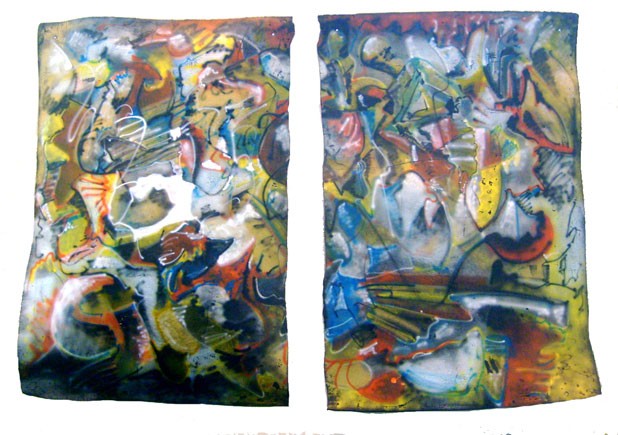
One of the Burlington area's most unusual visual art venues is its airport. Curated by Burlington City Arts, three parts of the facility provide moments of aesthetic respite for travelers bustling to and from gates, baggage-claim conveyer belts and the cavernous parking garage.
Through July, the Skyway space presents a strong group of 10 pieces by Joshua Nase. He seems to deploy a "kitchen-sink strategy" in creating his abstractions, and that includes the use of recycled materials. Nase's most unusual recycling tactic involves his choice of painting surfaces. Varieties of "salvaged foam," like the stuff used for packing material and insulation, are among his preferred painting supports. Nase's large-scale "Triumphant Rejuvenation I & II" works were executed in airbrush on roughly 48-by-60-inch vertical sheets of foam.
"Triumphant Rejuvenation I" contains a welter of calligraphic squiggles and lines interwoven with layers of broad patches of hue. Nase's airbrush adds transparent mists of color. But his approach isn't totally chaotic, and subtle harmonies reveal themselves within the chromatic mélange. Pale blues and their orange complements are particularly striking. Values range from white to black, and Nase's organization of the whites in both paintings is what gives them compositional structure.
Nase is a well-schooled painter who studied at Rhode Island's Roger Williams University and in Rome. He seems particularly influenced by Kandinsky. "Rome I-IV," Nase's series of 21-by-28-inch acrylics on canvas, reveals a more delicate approach to line than he accomplishes in his airbrush work. In the black-and-white "Rome II," controlled currents and crosscurrents of loopy brushwork create sweeping rhythms distributed evenly over the image.
Besides painting on recycled foam, Nase also breaks the picture plane by cutting into it. The vertical 26-by-60-inch "Layered Landscapes" is severed into two sections that are framed together in cast-off wood. Painted in fairly thin drips, splatters and smears - again with a palette of just black and white - the pink foam shows through the upper layers.
Another exhibition occupies a space near Gates 1 and 2. Memphis Barbree's photojournalistic journey, entitled "Tibet in Exile," comprises 10 16-by-20-inch color photos taken at Dharmsala, India, the Dalai Lama's seat of government in exile. The photos are part of a larger series from March 2006, called "The Way of the Bodhisattva," that can be found on Barbree's website.
The photographer has a keen eye for human rhythms and brilliant color. The crimson-robed monks of Dharmsala appear in groups: a row of monks met by a beggar; ranks of monks facing the camera and chanting. While the pieces have titles, the text posted beside the show doesn't help much in discerning which titles go with which images - with one exception. "Dalai Lama Tea Break" is a portrait of the beatific 14th Dalai Lama bundled in a red robe and smiling as he lifts a cup of tea. It's a nearly monochromatic image, with only calm, tan hues and a few distant pale grays, in addition to muted red.
Looming above an escalator is a wide wall that BCA dedicates to large-scale works; its exhibits last longer than do those in the other two spaces. Dan Gottsegen's monumental oil painting "Potash Creek" is installed there through this year. T oo bad it's only seen quickly in passing by travelers headed downstairs. The naturalistic abstraction of a wooded Vermont creek is a tangle of details and unexpected hues, from purples to turquoise to hints of autumnal yellow and orange. The piece seems to be about 5 by 7 feet in scale. Maybe after its tenure above the escalator, "Potash Creek" will hang some place where viewers can linger over it.
Airports don't really encourage lingering - unless, of course, your plane is late. Then taking in the art is a good way to pass the time.










Comments
Comments are closed.
From 2014-2020, Seven Days allowed readers to comment on all stories posted on our website. While we've appreciated the suggestions and insights, right now Seven Days is prioritizing our core mission — producing high-quality, responsible local journalism — over moderating online debates between readers.
To criticize, correct or praise our reporting, please send us a letter to the editor or send us a tip. We’ll check it out and report the results.
Online comments may return when we have better tech tools for managing them. Thanks for reading.